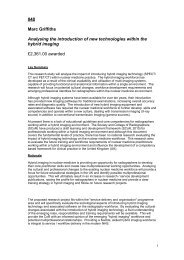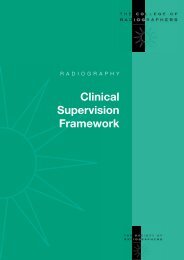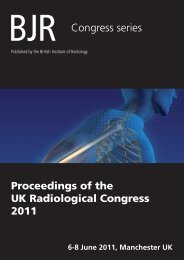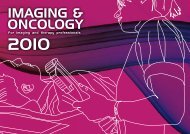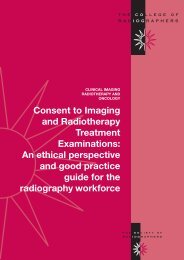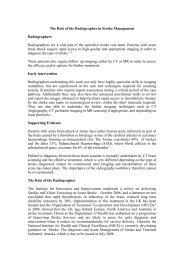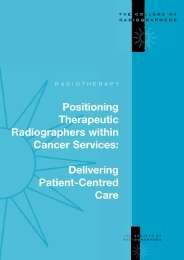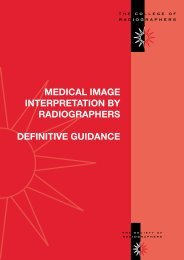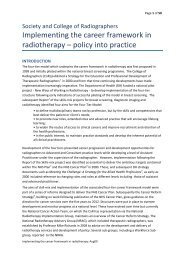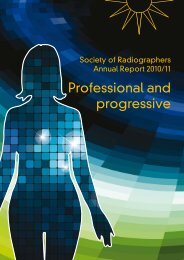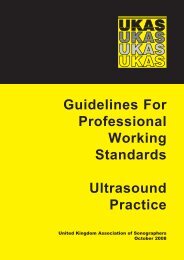SoR Brochure Child and Law SGG-82330 NEW - Society of ...
SoR Brochure Child and Law SGG-82330 NEW - Society of ...
SoR Brochure Child and Law SGG-82330 NEW - Society of ...
You also want an ePaper? Increase the reach of your titles
YUMPU automatically turns print PDFs into web optimized ePapers that Google loves.
3. Initial Concerns: Where a radiographer during normal dailywork may have concerns about a child in his/her care3.1 Research undertaken by the NSPCC shows that a significant minority <strong>of</strong> children in the UKsuffer serious abuse <strong>and</strong> neglect with 16 per cent <strong>of</strong> children experiencing seriousmaltreatment by parents 27 . Figures from 2003 showed that in that year there were 32,700children on child protection registers in the UK 28 .3.2 Figures like this mean that radiographers may come across potential or actual instances <strong>of</strong>child abuse <strong>and</strong> neglect in their normal daily work. When carrying out any examinations onchildren radiographers must be cognisant <strong>of</strong> the possibility <strong>and</strong> must be vigilant.Radiographers should familiarise themselves with local procedures for safeguarding thewelfare <strong>of</strong> children. They should find out where they are kept in the department <strong>and</strong> ensurethat they have read them.3.3. The child protection responsibilities <strong>of</strong> the radiographer are defined into two distinctcategories:3.3.1. Personal <strong>and</strong> pr<strong>of</strong>essional protection <strong>of</strong> the child3.3.2. Undertaking imaging for diagnostic, clinical <strong>and</strong> evidential purposes.Under either category the main priority is the child’s safety 21 .3.4 As part <strong>of</strong> the routine care <strong>of</strong> children, radiographers (therapeutic <strong>and</strong> diagnostic) are <strong>of</strong>tenwell placed to detect the possible signs <strong>of</strong> physical abuse where suspicions may bearoused both from appearances in the images produced <strong>and</strong> from marks on the child’sbody, eg bruising, cigarette burns, strap/belt marks. The younger the child, the more theyare at risk from physical harm <strong>and</strong>, in this age range, injuries to the head, eyes, ears <strong>and</strong>mouth should be viewed with suspicion.3.5 The diagnostic radiographer is also in a position to ascertain whether the radiographicappearance <strong>of</strong> any injury is consistent with the explanation provided by the child, the parentor the carer. Previous x-ray images taken at the hospital should be sought. Anyconcerns/suspicions must be drawn to the attention <strong>of</strong> the appropriate persons (see 3.8).The radiographer should not assume that other health care workers might have reportedsuch; it is better that two (or more) persons voice suspicions than none.3.6 Also, if the radiographer has concerns/suspicions that the sibling <strong>of</strong> a child being examinedor the child <strong>of</strong> one <strong>of</strong> her/his patients is being abused s/he must draw these concerns tothe attention <strong>of</strong> appropriate persons (see section 3.8). The radiographer should not assumethat other health care workers might have reported such; again it is better that two (ormore) persons voice suspicions than none.3.7 If the radiographer has any concerns (see sections 3.4 <strong>and</strong> 3.5) s/he should underst<strong>and</strong>that the hospital trust has child protection procedures which must be followed (see section1.14). The Climbié inquiry emphasised the importance <strong>of</strong> pr<strong>of</strong>essionals sharing informationin order to keep children safe from harm.3.8 In the event <strong>of</strong> any concerns, the radiographer must:3.8.1. Discuss immediately any concerns initially with a senior member <strong>of</strong> staff. In theevent <strong>of</strong> working single h<strong>and</strong>ed that staff member may be outside the clinicaldepartment.3.8.2. Immediately make a detailed record <strong>of</strong> the observations leading to suspicion <strong>and</strong>the action taken. This record must show timings, be dated, signed <strong>and</strong> witnessed<strong>and</strong> a copy kept in safe keeping in the department.3.8.3. Contact one <strong>of</strong> the named persons identified as a member <strong>of</strong> the NHS Trust childprotection team (or equivalent in the private sector) <strong>and</strong> provide them with a copy<strong>of</strong> the record made.10





